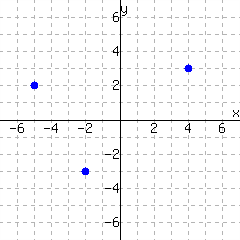The graph in
Figure 14 does
not make
\(y\) a function of
\(x\text{.}\) Two ordered pairs on that graph are
\((-3,1)\) and
\((-3,-2)\text{,}\) so an input value is used twice with different output values.
The graph in
Figure 15 does
not make
\(y\) a function of
\(x\text{.}\) There are many ordered pairs with the same input value but different output values. For example,
\((2,-2)\) and
\((2,4)\text{.}\)
The graph in
Figure 16 does make
\(y\) a function of
\(x\text{.}\) It appears that no matter what
\(x\)-value you choose on the
\(x\)-axis, there is exactly one
\(y\)-value paired up with it on the graph.
The graph in
Figure 17 does make
\(y\) a function of
\(x\text{,}\) but we should discuss. The hollow dots on the line indicate that the line goes right up to that point, but never reaches it. We say there is a “hole” in the graph at these places. For two of these holes, there is a separate ordered pair immediately above or below the hole. The graph has the ordered pair
\((-4,4)\text{.}\) It
also has ordered pairs like
\((\text{very close to }{-4},\text{very close to }0)\text{,}\) but it does not have
\((-4,0)\text{.}\) Overall, there is no
\(x\)-value that is used twice with different
\(y\)-values, so this graph does make
\(y\) a function of
\(x\)
The graph in
Figure 15 does
not make
\(y\) a function of
\(x\text{.}\) There are many ordered pairs with the same input value but different output values. For example,
\((0,1)\text{,}\) \((0,3)\text{,}\) \((0,-1)\text{,}\) \((0,5)\text{,}\) and
\((0,-6)\) all use
\(x=0\text{.}\)
The graph in
Figure 15 does
not make
\(y\) a function of
\(x\text{.}\) There are many ordered pairs with the same input value but different output values. For example at
\(x=2\text{,}\) there is both a positive and a negative associated
\(y\)-value. It’s hard to say exactly what these
\(y\)-values are, but we don’t have to.








